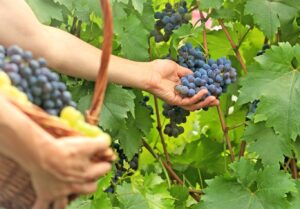When discussing wine and praising its virtues, terms like crianza, reserva, aging, or maturation are often used as synonyms for quality. This has sometimes led to the misconception that young wine is less significant. Nothing could be further from the truth. In this article, we’ll explain what a young wine is, its virtues, and its unique traits so you can enjoy it this summer.
A young wine is generally understood as one that has not undergone an aging or maturation process after alcoholic and/or malolactic fermentation. This typically means it hasn’t been aged in barrels, although it might have spent some time in concrete tanks or clay amphorae. Essentially, these wines are ready for consumption roughly 2 to 4 months after the harvest.
As a result, young wines are typically wines of the same year (in the southern hemisphere, where the harvest occurs in our spring) or the previous year (mainly in the northern hemisphere, where the harvest takes place between September and October).
Thanks to this short production process, young wines are the most fruit-forward, showcasing the unique characteristics of the grape varieties used. Interestingly, the traits of these wines are not only shaped by their production methods but also by the careful selection of grapes.

Think of wine and people: preparing for a short stroll in the park each morning is not the same as training for a marathon. Similarly, a young wine is designed to be consumed within a relatively short time, and its structure must reflect that purpose.
The “muscle” and “skeleton” of a wine come from components called tannins and anthocyanins, found in the grape’s skin and seeds. The more tannins and anthocyanins a wine has, the greater its aging potential. For young wines, grapes with lower tannin levels are ideal, creating a softer and more approachable wine that’s enjoyable almost immediately.
These grapes often come from younger vines, although older vines can also produce young wines if the production process is carefully managed.
The extraction of tannins and anthocyanins occurs during maceration, where the grape juice (must) is in contact with the skins and seeds during fermentation. For young wines, this process involves lower fermentation temperatures, shorter maceration times, and often occurs during the “aqueous phase” (when there is more sugar than alcohol in the fermentation). This helps extract the aroma and flavor of the grapes while minimizing tannin extraction, resulting in fresh, fruity wines.
It’s generally not advisable to drink a young wine more than five years after its production, but this depends on several factors:
The key is understanding that young wine offers a different experience—one focused on fresh, fruity flavors. Delaying its consumption can lead to a less enjoyable experience, as the wine’s intended characteristics might diminish over time.
The color of a wine can help identify its age and style:
The flavor and aromas: two essential aspects.
As we’ve been explaining, a good young wine reflects the grape variety it’s made from. It’s the closest thing to a light grape juice, though with a well-balanced touch of alcohol that enhances the nasal aftertaste, intensifying the sensations.
Thus, red wines will evoke fresh red and black fruits (strawberries, raspberries, cherries, plums, etc.), floral notes (mainly violets), and even some sweet nuances on the palate and nose, reminiscent of lollipops or fine jams.
White wines, on the other hand, may recall white or stone fruits (apples, pears, peaches, apricots), flowers (roses, jasmine, etc.), and even herbaceous or vegetal notes. On the palate, they stand out for their freshness, with a more pronounced acidity.
Rosés tend to exhibit aromas of red fruit, floral notes, and above all, a sweet character, often presenting hints of caramel.
While reserva wines are true masterpieces, this does not mean that young wines lack personality. For many, they’re seen as little more than grape juice with alcohol. It’s understandable that some may miss the wood-aged flavors, but labeling young wine as second-rate is a significant misconception.
Young wines don’t exhibit the complexity of tertiary aromas typical of barrel aging, but they instead tend to express terroir much more clearly, allowing for a better appreciation of differences in soil types, climates, and regions.
There’s a unique category where the benefits of young wine and aging combine: “Roble” wines. Originating in Ribera del Duero and pioneered by Pradorey in 1997, these wines undergo brief barrel aging to refine their freshness and fruitiness.
This innovation allowed Ribera del Duero to transform its winemaking and become a recognized denomination of origin. Today, Ribera del Duero boasts nearly 300 wineries, compared to just 85 in 1997.
Pradorey continues to innovate, producing young wines with subtle barrel aging and even aging in clay amphorae. Pradorey Origen reimagines the traditional Roble, reviving ancestral winemaking methods.
We hope this article has helped change your perspective on young wines. Perhaps now you’re tempted to open a bottle, pour yourself a glass, and savor the vibrant flavors that make young wines a unique and expressive choice.
¿Te ha gustado este artículo?